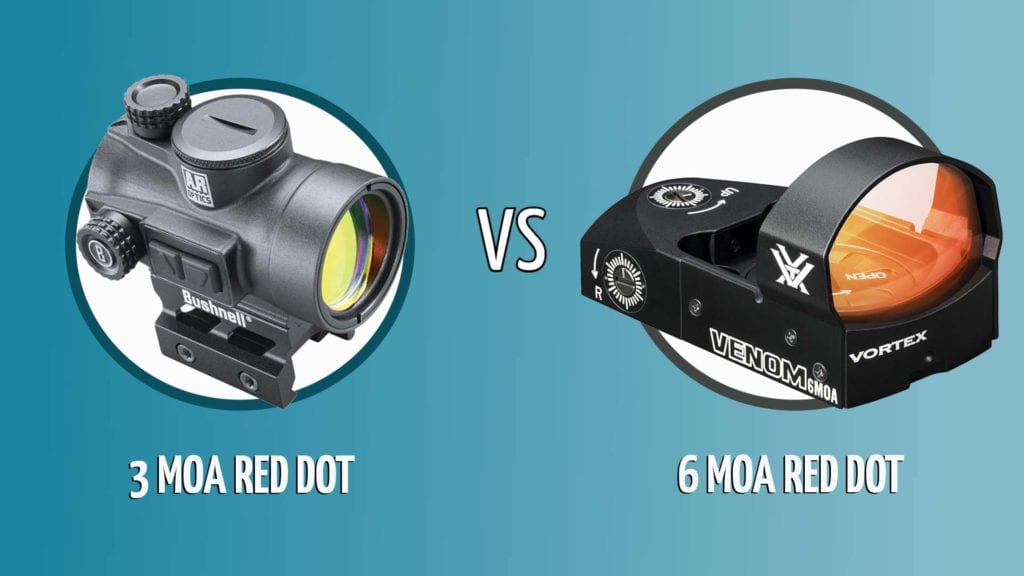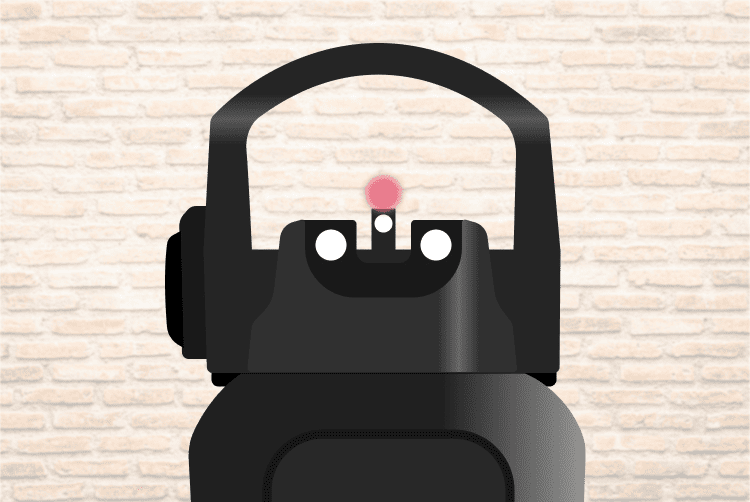3 MOA vs 6 MOA Red Dot Sights: What’s the Difference?
Last Updated on

Red dot sights are a type of optic that can be put on a firearm to simplify the aiming process compared to the iron sights that come stock with most guns. With iron sights, the rear sight and front sight need to be aligned both horizontally and vertically to provide accurate results. With a red dot, you simply put the little red dot onto the target.
Red dots can either be reflex sights or holographic sights, but either way, the technology allows the functionality of a front and rear sight to be combined into a single, easy-to-use, electronic dot. Red dots come in a variety of shapes and sizes, and even though they are all very similar in concept, there is a lot of variety that can affect how appropriate a specific red dot sight can be for a specific use case.
In this article, we want to go over one of the most common (and important) differences between red dots: the size of the dot itself. Two of the most common options are red dots that are 3 MOA and 6 MOA in size. Read on while we break down the differences.
MOA Explained
MOA stands for Minute of Angle, and it’s a measurement of the distance around the circumference of a circle. A circle is 360 degrees all the way around. An MOA is 1/60 of 1 degree, so all the way around a circle would be 21,600 MOA.
If you imagine you are standing in the exact center of a circle with a radius of 100 yards, 1 MOA would equal almost exactly 1 inch. At 50 yards, 1 MOA is just about ½ inch, 25 yards about ¼ inch, and so on. This will be important to understand as we compare 3 MOA red dot sights and 6 MOA red dot sights.

Overview of 3 MOA Red Dot Sights:
MOA is a fairly small unit of measurement. Consider how difficult it would be to see something only an inch long (like a tootsie roll) from 100 yards away. A 3 MOA dot is a circular dot that has a diameter of 3 MOA. This means that at 100 yards, it would block 3 inches of your target from view, and at 10 yards it would block about a ⅓ inch of your target.
https://www.instagram.com/p/-vH-xAwy9Y/
What It’s Best For
Three MOA red dots are often the better choice when you are prioritizing accuracy and precision, or when you are shooting at longer distances. Since a 3 MOA dot would only cover 3 inches of your target at 100 yards, you can still be reasonably accurate at that distance assuming you can see your target at all. The main drawback with 3 MOA dots, however, is that they are not as easy to see, and can take longer to line up with your target.
Choose Your Weapon
Three MOA dots are more common to see on rifles than on handguns since rifles are more likely to be shooting at longer distances and the optic will likely be much closer to your eye than on a handgun. Handguns are held somewhere around 15 inches away from your eye when you shoot, which makes the 3 MOA dot quite difficult to spot in some circumstances.
On a rifle, however, the sight may only be 4-5 inches away from your eye, so the 3 MOA dot is much clearer and easy to separate from the target area.
- Doesn’t block as much of the target from view
- Pairs well with a chevron, horseshoe, or other reticle features
- Works better at longer distances
- Works better on rifles
- Harder to see
- Target acquisition is slower
- Doesn’t work as well on handguns

Overview of 6 MOA Red Dot Sights:
A 6 MOA red dot manages to solve most of the problems with a 3 MOA dot but creates some additional problems of its own. Being double the size, it also covers double the amount of your target. At 100 yards, it covers more than 6 inches of the target. Considering that the target may only be 8-10 inches in the first place, that doesn’t give you a lot of accuracy, even if you’re doing everything else perfectly.

What It’s Best For
Six MOA dots are best in short-range scenarios, especially under 25 yards. They also have the right benefits to be a great fit for defensive use, since these situations mostly happen within 25 yards and the need for accuracy isn’t as demanding as precision shooting. As long as you’re able to hit center mass on your target, you’re fine, so it makes more sense to prioritize fast target acquisition and ease of use, both of which a 6 MOA dot excels at.
Choose Your Weapon
All this makes 6 MOA dots better for handguns than for rifles. They can work fine on a rifle, but if you want the ability to shoot accurately past 25 yards, then you’ll start to run into the limitations of the 6 MOA dot. From 15 inches away the 6 MOA dot is much easier to see, which allows you to acquire your target and squeeze off your first round faster than if you’re using a 3 MOA dot. This is true even if you have perfect vision.
- Fast target acquisition
- Works well on handguns
- Great for defensive use
- Easy to see
- Not as good on rifles
- Blocks more of the target from view
- Not as accurate

Other Factors To Consider
Speed vs. Precision
No one knows better than you what should be your priority here. If you practice often with your firearm and feel very comfortable with it, then you may be able to acquire your target as quickly with a 3 MOA dot as a 6 MOA dot. If you’re relying on your firearm for defense, though, then using a 6 MOA dot can help compensate for adrenaline and nerves when a life-threatening situation arises.
Target shooting and other precision uses will be easier with a 3 MOA dot.
The Cost Factor
There is not much of a cost difference between 3 MOA dots and 6 MOA dots, generally speaking. You’ll be able to find plenty of high-end options for each as well as budget options for each. The cost will have more to do with the brand and model that you select than what size of dot it has.
Another thing to consider is battery life. Assuming there is nothing else on the reticle besides the dot, a 6 MOA dot will use up power faster than a 3 MOA dot. The difference here is minimal, however, and not a cause for concern, though technically you would save money with a 3 MOA dot over time.
The Rest of the Reticle
Many red dot sights are just that: a red dot. But more and more sights are coming with reticles that are a bit fancier than just a simple red circle in the middle. You can get red dots with BDC ladders, rangefinders, and even Christmas tree reticles that assist with taking shots much further out than 100 yards.
Most of these additions are only helpful at long ranges, but if you zero in at 25 yards then having more than just a dot in the middle can help with shooting out to 100 yards and beyond. Most of what you’ll see will be a circle, horseshoe, or chevron surrounding the center dot to give you reference points above, below, and to the side of the dot as you are estimating holdovers.
Having something like a circle around the dot can help make the best of both worlds by allowing you to use a 3 MOA dot in the middle for longer shots and the circle for fast target acquisition. It can take a little bit of practice, but it can give you faster target acquisition than a 6 MOA dot while still giving you the precision of a 3 MOA dot.

In Conclusion
Both types of red dots are perfectly functional and will work in a variety of situations, but a 3 MOA red dot is generally better for higher precision and longer distances, while a 6 MOA red dot gives you faster target acquisition and is easier to see. Your plans for the firearm you intend to mount the sight onto should determine which of those is the right fit and which is the one to pass by.
Featured Image: Santipong Srikhamta, Shutterstock
About the Author Robert Sparks
Robert’s obsession with all things optical started early in life, when his optician father would bring home prototypes for Robert to play with. Nowadays, Robert is dedicated to helping others find the right optics for their needs. His hobbies include astronomy, astrophysics, and model building. Originally from Newark, NJ, he resides in Santa Fe, New Mexico, where the nighttime skies are filled with glittering stars.
Related Articles:
How to Clean a Refractor Telescope: Step-by-Step Guide
How to Clean a Telescope Eyepiece: Step-by-Step Guide
How to Clean a Rifle Scope: 8 Expert Tips
Monocular vs Telescope: Differences Explained (With Pictures)
What Is a Monocular Used For? 8 Common Functions
How to Clean a Telescope Mirror: 8 Expert Tips
Brightfield vs Phase Contrast Microscopy: The Differences Explained
SkyCamHD Drone Review: Pros, Cons, FAQ, & Verdict
